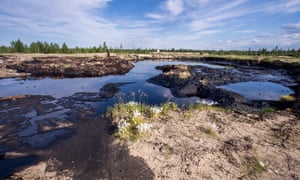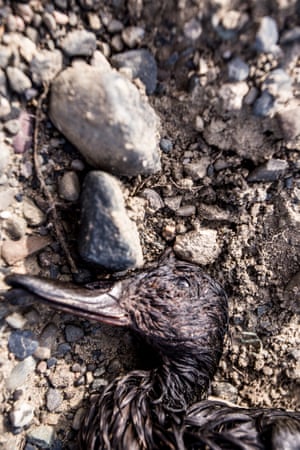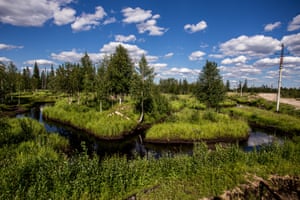Oil spills in the Komi Republic caused by old pipelines are relatively small and rarely garner widespread attention - but added up they threaten fish stocks and pasture for cattle

Small but numerous spills in the Komi Republic threaten fish stocks, pasture land and drinking water. Photograph: Gleb Paikachev
Alec Luhn in Usinsk
Friday 5 August 2016 01.00 EDT
The Komi Republic in northern Russia is renowned for its many lakes, but sites contaminated by oil are almost just as easy to find in the Usinsk oilfields. From pumps dripping oil and huge ponds of black sludge to dying trees and undergrowth — a likely sign of an underground pipeline leak — these spills are relatively small and rarely garner media attention.
But they add up quickly, threatening fish stocks, pasture land and drinking water. According to the natural resources and environment minister, Sergei Donskoi, 1.5m tonnes of oil are spilled in Russia each year. That’s more than twice the amount released by the record-breaking Deepwater Horizon oil spill in the Gulf of Mexico in 2010.

A dead bird covered in oil in the Komi Republic. Photograph: Gleb Paikachev
The main problem, according to the natural resources ministry, is that 60% of pipeline infrastructure is deteriorated. And with fines inexpensive and oversight lax, oil companies find it more profitable to patch up holes and pour sand on spills — or do nothing at all — than invest in quality infrastructure and comprehensive cleanups, according to activists.
“The pipelines are very worn out, they’re left over from the USSR,” said Greenpeace research projects coordinator, Vasily Yablokov. “The oil companies have realised they’re losing a lot of oil and are starting to replace them, but it’s laughable. They need to do much more.”
While Russia’s oil and gas production provides more than half the state budget every year, it exacts a huge price on the environment and local residents. A state energy statistics bureau told Greenpeace it had registered 11,709 pipeline breaks in Russia in 2014. In contrast, Canada reported five pipeline accidents (involving human injury) and 133 incidents involving natural gas and oil pipelines in 2014.
The Komi Republic is where Russia’s first oil production facility opened in 1745, and the Soviet Union started developing the country’s modern oil industry here in the 1960s and 70s. Usinsk, a sleepy town of 39,000 people, is the regional oil hub. The Usinsk oil field is licensed largely to Lukoil, which bought its Komi oil drilling assets from Komitek in 1999 and began expanding production.
“More Usinsk oil to the motherland!” giant letters proclaim on top of one prefab flat block. Just south of the Arctic Circle, the sun doesn’t even set in Usinsk in the summer, and it’s reachable by car only when rivers freeze to make “winter roads”. Russi oilfields map
Komi’s aging oil infrastructure has been prone to accidents. In 1994, a pipeline break in Usinsk gushed up more than 60,000 tonnes of oil (many estimates put that figure at twice as much), one of the biggest spills ever on land. Spills in 2013, 2014 and 2015 released hundreds of tonnes of oil on to the snow and river ice.
Greenpeace says that in 2014, a 10-day “oil patrol” by its volunteers discovered 201 contaminated sites (mostly from pipeline breaks) in the Usinsk oilfield, which is licensed largely to Lukoil, and filed official complaints for each. A trip organised by Greenpeace and the local news site 7x7 in July reported that at least six of these sites were still filled with oil.
At a meeting with journalists and Greenpeace, Lukoil-Komi representatives said the 201 sites had been investigated and no oil spill was found at 67 of them.However, Greenpeace has photographs of violations at every site. Representatives admitted the subcontractor that checked the sites could have mistaken the coordinates of some of them. According to Lukoil spokesman Sergei Makarov, a new programme by the company has liquidated more than 50 pools of leaked oil.
But since satellite imagery has shown likely spills in areas of the Usinsk oilfields that Greenpeace cannot access, the actual number of contaminated sites is likely far higher than 201, Yablokov believes.
“It’s like a train that they’re laying rails under as it goes, it goes further and they lay more rail, and that train is oil extraction in the regions,” Yablokov said.
Besides the six known sites, Greenpeace said the July visit also found three new oil spills along the way, including one near a site that Greenpeace volunteers removed 20 tonnes of oil from in 2014.
At the site of one pipeline break, the Guardian saw that a large amount of oil had been removed by Lukoil workers and the site considered “reclaimed”. But the haphazard canals criss-crossing it were still full of thick, unctuous water with a rainbow film on top, and white paint on the birch tree trunks could not cover the black trace of oil, Greenpeace says.
Locals in the villages around Usinsk complain that the frequent oil spills pollute their drinking water, contaminate the river fish and reindeer they depend on for food and cause chronic health conditions.
Statistics obtained in 2010 by local activists from the hospital in Ust-Usa, a village of 1,300 on the Pechora river that has suffered from many of the large spills, showed rises in almost every kind of illness. Nervous system illnesses in adults, for instance, grew from 26 in 1995 to 70 in 2009. In patients under 18 years of age, they skyrocketed from 72 to 254.
Spokesman Sergei Makarov said Lukoil-Komi was investing 20bn roubles (£230m) in environmental measures and would change 370km of old pipeline in 2016, out of a 7,000km-long pipeline network in the region. The company reported only six oil spills in 2015, although Makarov admitted “some of our employees don’t want to report (spills) because a leak means poor quality work”.
In late May, more than 50 residents of Ust-Usa protested the effects of oil drilling and plans for a new oil well near the village. Lukoil Komi plans to increase its production from 15.8m tonnes of oil in 2014 to 21.5m tonnes in 2019.
“We’re not telling oil companies to leave, we are saying drill in a way so that we can live with clean air and water,” local biology teacher and activist Yekaterina Dyachkova said. “Of course we depend on oil companies because there is no other work.”

Canals full of oily water created during the cleanup process. Photograph: Gleb Paikachev
The aftermath of oil spills isn’t limited to Komi. Northern rivers such as the Pechora carry 500,000 tonnes of oil into the Arctic Ocean every year, the state hydrometeorology and environmental monitoring service reported in 2011. More than 11,000 people have signed a Greenpeace petition demanding oil companies be required to replace by 2022 all oil pipelines more than 25 years old.
Without stricter enforcement, the situation is unlikely to change. The average return on assets for oil companies in Russia was twice as high as in other countries, according to a recent Greenpeace report. That’s thanks to huge government tax breaks and subsidies, as well as “conditions in which oil companies are able to avoid full financial responsibility for oil spills” and not replace pipelines, it said.
“We need the cost of oil drilling to include protecting nature,” Yablokov said. “It won’t be quite as profitable a business, but we will be able to preserve the environment.”